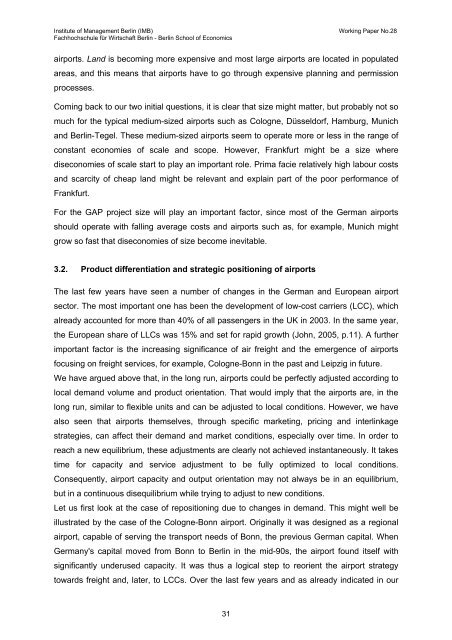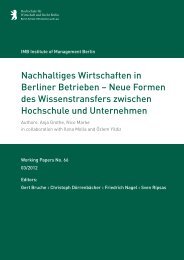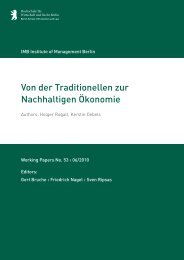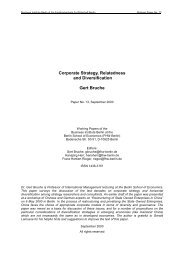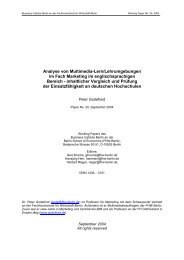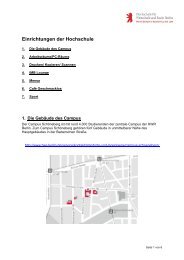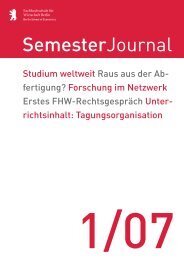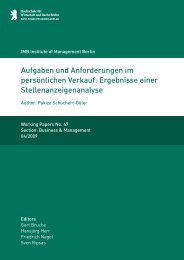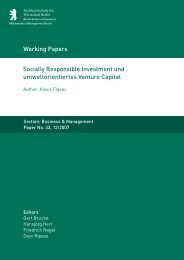Working paper template - MBA Programme der HWR Berlin
Working paper template - MBA Programme der HWR Berlin
Working paper template - MBA Programme der HWR Berlin
Create successful ePaper yourself
Turn your PDF publications into a flip-book with our unique Google optimized e-Paper software.
Institute of Management <strong>Berlin</strong> (IMB) <strong>Working</strong> Paper No.28<br />
Fachhochschule für Wirtschaft <strong>Berlin</strong> - <strong>Berlin</strong> School of Economics<br />
airports. Land is becoming more expensive and most large airports are located in populated<br />
areas, and this means that airports have to go through expensive planning and permission<br />
processes.<br />
Coming back to our two initial questions, it is clear that size might matter, but probably not so<br />
much for the typical medium-sized airports such as Cologne, Düsseldorf, Hamburg, Munich<br />
and <strong>Berlin</strong>-Tegel. These medium-sized airports seem to operate more or less in the range of<br />
constant economies of scale and scope. However, Frankfurt might be a size where<br />
diseconomies of scale start to play an important role. Prima facie relatively high labour costs<br />
and scarcity of cheap land might be relevant and explain part of the poor performance of<br />
Frankfurt.<br />
For the GAP project size will play an important factor, since most of the German airports<br />
should operate with falling average costs and airports such as, for example, Munich might<br />
grow so fast that diseconomies of size become inevitable.<br />
3.2. Product differentiation and strategic positioning of airports<br />
The last few years have seen a number of changes in the German and European airport<br />
sector. The most important one has been the development of low-cost carriers (LCC), which<br />
already accounted for more than 40% of all passengers in the UK in 2003. In the same year,<br />
the European share of LLCs was 15% and set for rapid growth (John, 2005, p.11). A further<br />
important factor is the increasing significance of air freight and the emergence of airports<br />
focusing on freight services, for example, Cologne-Bonn in the past and Leipzig in future.<br />
We have argued above that, in the long run, airports could be perfectly adjusted according to<br />
local demand volume and product orientation. That would imply that the airports are, in the<br />
long run, similar to flexible units and can be adjusted to local conditions. However, we have<br />
also seen that airports themselves, through specific marketing, pricing and interlinkage<br />
strategies, can affect their demand and market conditions, especially over time. In or<strong>der</strong> to<br />
reach a new equilibrium, these adjustments are clearly not achieved instantaneously. It takes<br />
time for capacity and service adjustment to be fully optimized to local conditions.<br />
Consequently, airport capacity and output orientation may not always be in an equilibrium,<br />
but in a continuous disequilibrium while trying to adjust to new conditions.<br />
Let us first look at the case of repositioning due to changes in demand. This might well be<br />
illustrated by the case of the Cologne-Bonn airport. Originally it was designed as a regional<br />
airport, capable of serving the transport needs of Bonn, the previous German capital. When<br />
Germany's capital moved from Bonn to <strong>Berlin</strong> in the mid-90s, the airport found itself with<br />
significantly un<strong>der</strong>used capacity. It was thus a logical step to reorient the airport strategy<br />
towards freight and, later, to LCCs. Over the last few years and as already indicated in our<br />
31


